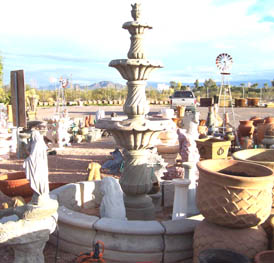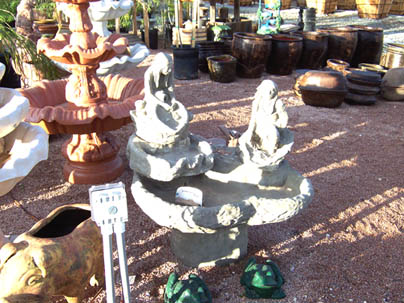Vines & Climbing Plants
Helpful Hints Before Installation
Stack your fountain in the exact
place you intend to install it,
stand back and view it from all directions.
If you like the way it looks then install it.
This saves you the work of tearing it down and moving it if it doesn’t look good
where you thought it would.
It’s a good idea to test the pump
as soon as you take it out of the box.
After you finish setting up your fountain
is not the time to find you have a bad pump.
Put in a bucket of water and plug it in.
You’ll know if it’s running.
Never let your fountain run dry.
Submersible pumps are made to run under water and running them without it
will hasten the end of their lifespan.
If you are installing your fountain
on ground that is soft or may get wet
it’s a good idea to give it a solid footing.
A large concrete step stone from your local nursery will serve well.

Secrets of Easy Pump Installation
In some center delivery fountains
there may be a 1/2-inch PVC female adapter
built into the bottom bowl of your fountain.
If so, there may be a brass adapter
included in your fountain kit.
Thread the brass fitting into that using
Teflon tape or other sealant.
Next, you cut the plug off the pump
leaving at least 3 feet of wire
connected to the pump.
Less wire left on the pump will void your warranty.
Pull the wire downward through the
hole, pvc pipe, or brass fitting,
leaving 6-8 inches of wire inside the bowl
so you can move the pump around.
Pull the wire through the notch in the bottom
of the fountain base then you can either
splice the plug back on
(give it a good coat of silicon sealer to waterproof)
or you can put on a new water resistant plug
or wire directly to an outdoor junction box with an “on-and-off’ switch in a convenient location.
Make sure your connection has ground field interrupter (GFI) in line somewhere.
(The spliced wire may be frowned upon by the Code Inspector).
The easiest way to accomplish the wiring job
is to put padding on the ground
and against the base and lean the bowl
against the base with the fitting for the wire
above the top of the base.
When you get the wire pulled through the fitting,
you can reach down inside the base and
push the wire through the notch
to the outside and pull it tight.
Then, simply tilt the bowl up into the base,
(keeping the wire tight), center it,
and remove the padding.
This method saves a lot of lifting and cussing.
If you are using a Little Giant pump
he color code on the wires is weird and you should know the colors.
They are as follows:
Little Giant Brown wire connects to the Hot/black wire
Little Giant Blue wire connects to the Common/white wire
Little Giant Yellow-green stripe goes to the Ground/greenor non insulated copper
Freeze Protection For Your Concrete
Unfortunately, due to the fact that we are “desert dwellers”,
we don’t know much about the effects of freezing temperatures on our products.
We will try to help you with the few facts we have.
Concrete is porous, similar to a sponge, and absorbs water like one.
When the temperature drops below freezing,
the water inside the concrete also freezes; expanding as it does.
When the water expands inside, the pores of the concrete cannot expand with it,
so the result is an explosion of sorts in each cell resulting in disintegration of the concrete
starting in the extremities and working inward.
The best way we have found to combat this in our products
is to keep the water from entering the concrete at all.
We achieve this by applying a complete paint job.
We paint every surface – over, under and in between.
Our standard paint job is applied only on exposed areas.
Once the unit is sealed and installed, you will want to drain the water before the first freeze.
Put some chunks of wood in the bowls (chips in smaller bowls) to absorb the water
that will drip in or condense in the unit.
Cover the unit with burlap or canvas.
These materials will breathe and won’t trap moisture like plastics will.
After you have taken these precautions, cross your fingers.
They will work most of the time but we hold no guarantees.
If you want to be 100% sure, take the unit inside where it’s warm!
Other Facts That May Be Helpful To You

All of our fountains are self-contained and
require no special plumbing.
All you need is an electrical receptacle
within a couple of feet.
An extension cord of any kind is not recommended
to connect your fountain pump.
To our knowledge there is no such thing as a waterproof extension cord.
Replacement pieces for our fountains
may be available through your dealer.
But handle your pieces carefully.
They are fragile and break easily with rough handling.
All of our products carry a limited warranty and service policy
Welcome to our world of moving water.
There is nothing in the world that compares
with the beauty and restful feelings you enjoy
watching and listening to your fountain.
How much Water is in my Fountain or Pond?
How to calculate the volume of water in gallons
Rectangular or square shape
Multiply depth x length x width x 7.5
Circular shape
Multiply depth x diameter (squared) x 5.9
Oval with straight sides shape
Multiply depth x length x width x 6.7
Free form shape
Find the average depth, length and width
Multiply depth x length x width x 6.7
How to calculate the surface area in square yards
Rectangular or square shape
Multiply length x width and divide by 9
Circular shape
Multiply the radius (squared) x 3.14
and divide by 9
Oval with straight sides shape
Multiply 1/2 of length x 1/2 of width x 3.14
and divide by 9
Free form shape
Find the average length and width
Multiply 1/2 of length x 1/2 of width x 3.14
and divide by 9
Your calculations will give you a close answer.
If you want complete accuracy you must use a bucket.
